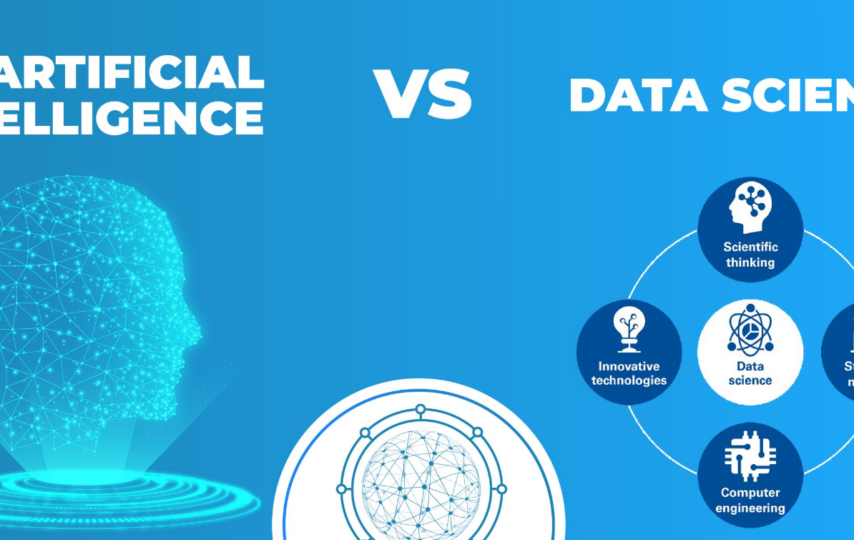Data science deals with processing data, while artificial intelligence makes machines intelligent for decision-making. However, the similarities and differences between the two go deeper. We’ll discuss data science and AI in detail to understand their role in today’s business world.
Data Science vs. Artificial Intelligence
Artificial intelligence, machine learning, big data, and data science are catchphrases in today’s market. Many enterprises, service providers, and vendors use the term to explain their processes. But the question remains- is data science the same as artificial intelligence?
What is data science, and what is artificial intelligence? Many times, the terms are used interchangeably, but are they really the same? Does it mean that a data scientist is an AI engineer or vice versa?
It gets confusing when you have to invest in a tool or hire an expert. Though artificial intelligence consulting companies help, it is easier when you are informed about the basics and know what you want for your organization.
This blog aims to explain the terms in detail and differentiate between the two. We’ll also discuss if data science is related to AI or how the concepts overlap to provide a comprehensive solution to run a business.
What Is Data Science and Artificial Intelligence?
What is Data Science
Data science refers to extracting relevant information from unstructured data. It is a combination of different subjects like statistics, computer science, and scientific processes (techniques).
Data science is the core of business decision-making in today’s world. It allows the executives to use historical and real-time data for analysis. The results from the analysis are used to make decisions.
Experts opine that data science is responsible for the fourth industrial revolution, thanks to the vast amounts of data available in the market. Data science blends domain expertise, mathematical and statistical knowledge, and computer science (programming, etc.) to process data. It derives patterns and trends that help us see things that were previously hidden/ unexplored.
What is artificial intelligence?
AI is a collection of complex algorithms that make a machine intelligent and capable of making decisions based on the given data. AI is where a computer is trained to learn and process information the way the human brain does. Data in large quantities are fed to the algorithms to train them and solve problems or take autonomous actions. Artificial intelligence is categorized into two types- general AI and applied AI.
As the names suggest, general AI deals with regular stuff like translating content from one language to another, identifying objects, recognizing sounds, speeding up social transactions, etc. Applied AI is more complex and technical. It is used to build self-driving cars, robots, etc., where the algorithms process data to detect patterns and make decisions.
Concepts like deep learning and natural language processing are a part of AI used to trace patterns and translate content from one language to another with greater accuracy and precision.
Does Data Science Include Artificial Intelligence?
Data science and artificial intelligence co-exist in the ecosystem. There is a difference of opinion about whether or not you need data science or AI and vice versa. However, the bottom line is that data science and AI are related. Machine learning is a combination of data science and artificial intelligence.
To answer the question, yes. Data science includes AI in certain applications. AI is not necessary for data science, but it has a role to play in some scenarios. For example, data science deals with data collection, cleaning, storing, processing, and analysis. These tasks are time-consuming and effort-intensive to be performed manually.
However using AI algorithms can automate the processes. AI speeds up data science models by taking over recurring tasks. Data scientists can oversee or monitor the process to ensure it is aligned with the business requirements. Similarly, data science contributes to some aspects of artificial intelligence but is not necessary for all processes.
Artificial Intelligence and Data Science: What’s the connection?
Data science and artificial intelligence help and enhance each other’s capabilities. In simple terms, AI is a tool for data science. AI powers systems to process huge amounts of data and deliver predictive insights. Data science helps AI algorithms to make data-backed decisions with greater accuracy.
Understanding the basics of data science (math and statistics) will make it easier for AI engineers to create algorithms. Programming and mathematical analysis are vital for AI experts to fine-tune their skills and create reliable data models. Data science deals with the research aspect, while AI deals with the application/ software development side. They are two sides of the same coin.
Data Science Vs. Artificial Intelligence
Let’s look at the differences between data science and artificial intelligence in various aspects.
- Processes
Data Science: Data mining, data analysis, and data visualization are the main techniques used in data science. Data mining involves extracting and discovering patterns in large datasets. It is a combination of computer science and statistics.
Data analysis is the process of cleaning, transforming, and modeling data to come up with useful insights, comparisons, and conclusions. Data visualization involves presenting insights in graphical format for easy comprehension. Different types of graphs, maps, charts, etc., are used to communicate the insights to the end user.
AI: Machine learning techniques and algorithms are an integral part of artificial intelligence. The processes are classified into different types based on complexity. For example, spam filters come under basic AI, but reactive machines belong to advanced AI.
In machine learning, neural networks constitute a subset and the core of deep learning algorithms. These are designed to mimic the way the human mind processes information and emotions using the neural networks in the brain.
- Necessary Skills
Data Science: Python or R, Statistics, SQL, NLP, TensorFlow, Jupyter Notebook, and expertise in data visualization tools like Power BI, Tableau, etc., are some must-have skills for data scientists.
AI: Python, Java, deep learning with TensorFlow, PyTorch, computer science, Scala, Spark, cloud architecture, system hardware, etc., are some skills required for AI engineers.
The skills for AI are software-based and focus on deployment. In many instances, the skills of data science and artificial intelligence overlap. Some jobs require AI engineers with a Ph.D. degree, while a Master’s degree is enough for data scientists.
- Technique
Data Science: Statistical techniques are vital in data science.
AI: Algorithms are crucial in artificial intelligence.
- Purpose/ Goal
Data Science: The goal of data science is to establish the problem statement. It helps understand your business needs through data analytics. Machine learning algorithms are used to solve the issues, while data visualization tools are used to create graphical reports of the insights.
AI: The purpose of AI is to develop new algorithms, use neural networks on large datasets, and, most importantly, automate the process to save time. The algorithms have to be fine-tuned to increase accuracy. AI engineers also have to develop more algorithms for different specifications and feed datasets to train them. Deploying AI algorithms involves neural networks and deep learning practices.
- Solutions
Data Science: It is used when a problem requires a mathematical solution. DS uses parts of the loop (created by AI) to find the solution to specific problems. EDA (Exploratory Data Analysis), which is a part of statistics, is used to summarize the main characteristics of the data fed to the DS model.
AI: It creates and represents the loops of perception used by data science to solve an issue. Artificial intelligence is used when repetitive work needs to b performed or when you have to make quick decisions. AI facilitates logical decision-making rather than emotional. However, the algorithm is only as unbiased as the data used to train it.
- Complexity
Data Science: It handles medium-level processing for data manipulation. DS can handle different types of data, like structured, unstructured, and semi-structured. It looks for patterns in data for decision-making.
AI: It deals with high-level processing and uses scientific data for manipulation. AI requires structured/ standardized data with vectors and embeddings. It deals with intelligence in data reports to make decisions.
- Representation
Data Science: Data is represented in a visual format using graphs (bar, line, pie, etc.), maps, and other elements. Data visualization tools share real-time insights through interactive dashboards. The dashboards are designed for end-users to access actionable insights even without possessing technical knowledge.
AI: It has algorithms and network node representation. The algorithm/ AI tool has to be connected to data visualization software to present the insights to the end user. Knowledge representation and reasoning are part of AI that deals with modeling data for computers to understand input and process it.
- Control
Data Science: It uses data analytics to control the models and drive insights.
AI: It uses robotics and machine learning to control the algorithms.
- Applications
Data Science: It is used in marketing, healthcare, advertising, optimizing business processes, understanding customer and market trends, analyzing financial data, assessing risk, detecting fraud, etc.
AI: It is used for automation, robotics, developing chatbots, self-servicing help desks, voice assistants, self-driving cars, online gaming, virtual reality, augmented reality, speech recognition, translation, etc.
- Tools
Data Science: It requires extensive use of several tools to build the data science model for analysis and reporting.
AI: It also requires tools but not as extensive as data science. Some tools overlap with data science and artificial intelligence.
Big Data Vs. Data Science Vs. Artificial Intelligence
Big data are large and complex datasets that cannot be processed by traditional applications or computing software. It requires the statistical approach of data science to be processed for insights. Big data is used in telecommunications, eCommerce, research and development, physical and cyber security, law enforcement, the financial sector, etc.
Big data and data science are inextricably interconnected and cannot be separated from one another. Big data and AI are also related, albeit differently. While big data is the raw input, AI is considered the output/ intelligence derived from processing this raw data.
- Data Type
Big data contains structured, unstructured, and semi-structured data collected from several sources. Data is in different formats and types (text, multimedia, tables, labels, etc.).
- Approach
While big data looks at the results, artificial intelligence acts on them. Data science is responsible for delivering the results by processing given input data.
For example, big data is used to understand the viewership trends in Netflix, and artificial intelligence is used to consider the insights to make decisions to increase viewership percentage, etc. Data science extracts the results from big data using scientific methods.
- Reasons for Formation
Big data is essential for AI algorithms. Artificial intelligence tools were not accurate in earlier times as they relied on small datasets and slow processors. Big data now allows the algorithms to learn from large datasets. This has enabled the algorithms to train through trial and error and make corrections using its built-in feedback loop. Data science helps create the processes and models that speed up training and improve the quality of AI and ML algorithms.
Conclusion
We can conclude that data science and artificial intelligence are essential to streamline your business processes and adopt the data-driven model to make decisions. Hiring the services of an offshore AI and DS company will be a cost-effective solution.
You can invest in tried and tested data models and AI tools that are customized according to your requirements. The data analytics company takes the responsibility of providing the necessary data science models and AI algorithms depending on your industry, business volume, and KPIs.








